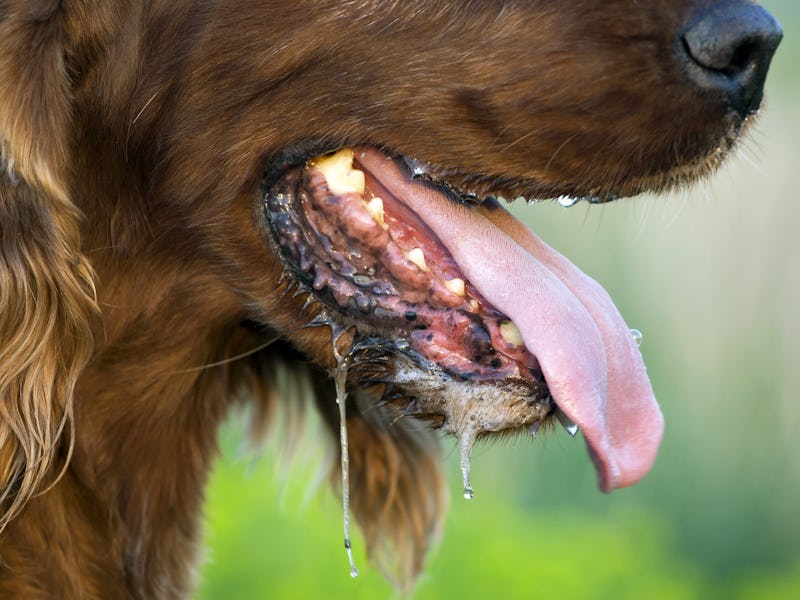Why is my dog green? Viral tweet explains the strange science of drool
Science can help you understand your dog's powerful spit.

It’s no secret that dogs drool. A lot. They might slobber to cool themselves down on a hot day or salivate when they’re anticipating a tasty bowl of kibble.
But dogs’ drool actually contains a strange superpower, as Twitter learned this week: it can turn your pup’s coat into a vibrant shade of green.
“The story begins with a lot of drool,” Stephanie Olson, an assistant professor at Purdue University’s Department of Earth, Atmospheric, and Planetary Sciences, wrote in a viral Twitter thread this week.
Let’s back up and explain. On July 18, Olson posted a Twitter thread about a mystery concerning her dog, Olive:
I was alarmed to discover that my dog turned GREEN overnight. I had no idea why. But it turns out that, as an early Earth geochemist, I was perfectly prepared to find out!
In the subsequent thread, Olson — who studies the geochemistry of early Earth — decided to use her scientific knowledge to crack the mystery of Olive’s new leprechaun coat. Her scientific undertaking fascinated the Internet by speaking to the weird science behind a dog’s sloppy drool.
Can drool change the color of a dog?
In short: yes. As Olson explained, a chemical reaction between a dog’s drool and its fur could change the color of its coat.
The first thing you need to know: Olive was wearing a dog cone, which acts as a barrier to prevent canines from scratching their wounds after surgery or while they’re healing from their injuries.
But the cone had an unintended side effect, as Olson discovered in the course of her Twitter analysis. While Olive slept, the cone trapped the dog’s excessive saliva on its neck.
Human saliva contains ferritin — a blood protein that doctors use to test iron deficiency in human children. Likewise, as Olson explains, dog saliva also contains iron.
Specifically, canines possess iron porphyrins, which are “iron-containing molecules produced when the body breaks down red blood cells,” according to veterinarian Michael Fox. As Olson explains, when iron porphyrins interact with oxygen in the air, they can form rusty red particles on a dog’s fur.
Olson: Dog saliva contains iron porphyrins. Upon contact with oxygen, the iron is oxidized to iron oxide nanoparticles. Rust, essentially. This is why Olive and many other drooly dogs have rusty red staining by their mouths."
Veterinarians refer to this rusty red effect as “tear staining” since porphyrins often get secreted through the dog’s tear, urine, and saliva.
However, the dog cone isolated Olive’s neck from the oxygen in the living room, producing a different — and greener — effect in the moist environment of the cone.
Saliva has many roles, including supplying nutrients to mouth bacteria. As Olson explains in the thread, bacteria in the saliva consumed the oxygen in the contained “neck swamp” created by the cone, turning Olive’s fur from red into a rare green rust color.
“And the staining along her neck transitioned from rusty red on her chin to rusty green thanks to the combination of her unusually moist neck environment and sustained isolation from oxygen in the air—both symptoms of the cone.”
Beyond transforming your pup’s coat, dog saliva also has some other important functions, including anti-inflammatory properties. Scientists have analyzed dog saliva to understand canine diseases and health conditions better.
What can cause dogs to turn green?
Why do dogs turn green? The answers might surprise you.
We’ve already learned how dog drool can transform your pup into an adorable leprechaun under unique circumstances.
As it turns out, there are more common reasons why your dog’s coat might turn green. For example, if your dog likes swimming in pools, you may have noticed its coat turning a pale green. That’s due to a chemical reaction between the dog’s fur and chemicals in the pool, similar to the green bleaching effect of chlorine on human hair. Chlorine oxidizes copper in the pool, which then binds to proteins in hair or fur.
The American Kennel Club suggests washing your dog’s coat with cool water immediately after swimming to remove any pool chemicals. Veterinarians have noted that oxidizing effects from other items, such as metal dog tags, may cause dog hair to change colors.
But in rare circumstances, your dog might turn green right out of the womb. In July 2017, pet owner Louise Sutherland told CNN that one of her dog’s newborn puppies had emerged with a shocking green coat.
Previous articles suggest that this green glow-up results from exposure to the anti-inflammatory molecule biliverdin, also known as green bile. Exposure to biliverdin in the mother’s womb can sometimes turn light-colored pups’ coats green.
Some medical studies have suggested that biliverdin may be associated with green jaundice — skin with a greenish tint — in humans, though other reports debunk this idea.
Ultimately, if your pooch starts changing colors, consult a veterinarian about the safest way to clean and return its coat to its usual sheen.
This article was originally published on